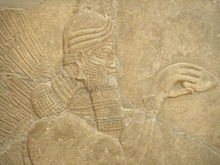Principal Reception Suite
The Principal Reception Suite ( PRS for short ) is the name given to the characteristic throne room unit of Neo-Assyrian palaces . Its centerpiece was a throne room, mostly decorated with reliefs or wall paintings, which could be entered from a forecourt through three entrances decorated with monumental reliefs. Inside the throne room was a throne pedestal on a narrow wall , behind which a niche was often designed with particularly artistic reliefs, mostly with cultic scenes. Opposite the dais of the throne was a stairwell behind an anteroom. In the larger palaces of the 8th and 7th centuries BC, particularly sumptuously equipped baths were located in the immediate vicinity of the throne pedestal. The side opposite the entrances had a passage that led via a smaller hall to an inner courtyard, to which the non-public parts of the palace were connected.
Throne room

The throne room served as the king's representative reception hall. It was always positioned in such a way that it could be entered from the forecourt of the palace without visitors being able to gain insight into the internal and private areas of the palace. As a rule, the three entrances to the throne room were along its longitudinal axis, mostly on the north side, so that the solar radiation was reduced. Some smaller palaces, e.g. B. Palace Z in Ḫorsabad , had only a single entrance to the throne room. In the case of throne rooms with three entrances, the two outer ones were designed somewhat smaller, while the central one was decorated with apotropaic figures or towers, often called Lamassu . On the narrow wall, to the left of the entrance, there was usually a stone pedestal on which the throne stood. The wall behind the throne pedestal was decorated with particularly elaborate orthostatic reliefs , which could also be set back in a niche. The throne pedestal itself could also be set in such a niche. In more recent palaces there was a comparable niche opposite the central entrance to the throne room, which led to the assumption that the throne was also placed there at least for a time. On the floor of the throne room there were usually grooves that led to just before the throne pedestal. The exact function of these structures is unclear, presumably they served as tracks for a heating device or as a base for heavy cult inventory.
Connecting room
The connecting room was directly connected to the throne room and connected it to the inner courtyard. To the side of this connecting room, further smaller chambers could be connected, which could possibly have been used as storage rooms or as accommodation for state guests. However, since large quarters for state guests were found in several palaces, this assumption remains hypothetical.
Anteroom and stairwell
Opposite the throne pedestal, in the center of the right narrow wall of the throne room, there was usually the passage to a small anteroom, which in turn led into a stairwell. The stairwell led to the roof of the palace or to an upper floor, which possibly served as the king's living room.
Baths
In some Neo-Assyrian palaces, the Principal Reception Suite also had sumptuous baths that were accessible either directly from the throne room or from the anteroom to the stairwell. Simpler variants were lined with mud bricks and sealed with bitumen and had a drain that could be closed with a clay plug. In Nimrud there were four prints around the drain, possibly from a kind of "toilet chair". The main task of the baths in the throne room, however, was likely to have been to restore cultic purity , as various text finds suggest (e.g. the "bit rimki" texts). More splendid complexes were decorated with orthostat reliefs, which mostly show ritual scenes and mythological figures.


